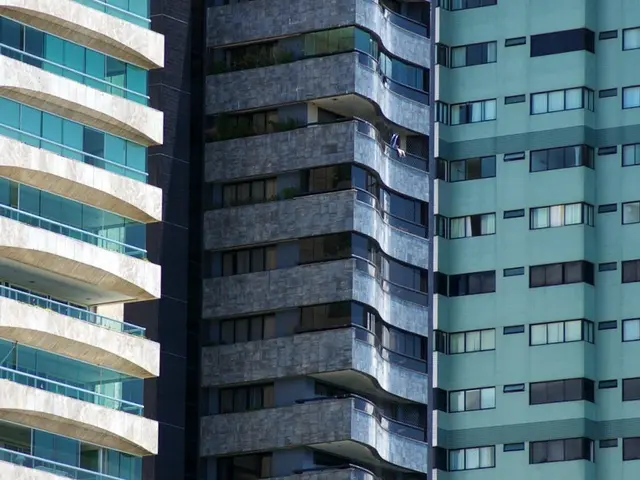Explores the potential connection between excess moisture and the development of Pressure Ulcers.
In a significant study, the association between prolonged contact with bodily fluids and the development of pressure ulcers has been highlighted. This research challenges the common perception that bedsores are solely associated with bedridden individuals.
Moisture lesions, a form of dermatitis caused by prolonged exposure to incontinence, are not the same as pressure ulcers. However, they do contribute to the vulnerability of the skin, making it more susceptible to pressure ulcers.
The wetness increases the skin-support coefficient of friction, softening the outer skin layers and making it easier for minor friction or pressure to break the skin barrier. This, combined with poor skin hygiene, can lead to skin maceration, reducing the skin's resistance to injury.
When combined with immobility and sustained pressure—which decreases blood flow and oxygen supply to skin and underlying tissues—this leads to skin ischemia, cell death, and ultimately the formation of pressure ulcers.
Pressure ulcers typically occur in bony areas of the body such as the shoulder, thigh, elbow, hips, ears, knee, heel, etc. They can appear like a blister or a purple patch and are circular in shape. Swelling over a bony region that is constantly under pressure can also indicate a pressure ulcer.
Prevention of pressure ulcers and moisture lesions is crucial. Caregivers should focus on keeping the bed dry to prevent these conditions. Frequent repositioning to relieve pressure, maintaining skin hygiene, using pressure-relieving support surfaces, and proper nutrition are all essential strategies in preventing pressure ulcers.
Interestingly, the study suggests that pressure ulcers can occur during patient repositioning or transportation, not just during a rested state. It's also worth noting that moisture alone does not cause pressure ulcers. Instead, it, along with other factors such as strain, friction, and external pressure, can facilitate their growth.
Using a zippered waterproof mattress cover can help keep the bed dry at night, reducing the risk of moisture-related skin maceration. Moisture lesions occur near regions where there is a skin fold, such as near the buttocks, breasts, or the back of the knee.
An Israeli study concludes that pressure ulcers are more likely to develop on moist skin, underscoring the importance of maintaining skin dryness in preventing these painful and potentially serious conditions. Prolonged contact with bodily fluids can damage the skin, making it vulnerable to pressure ulcers and other musculoskeletal disorders.
In conclusion, by focusing on maintaining skin hygiene and preventing moisture-related skin maceration, caregivers can significantly reduce the risk of pressure ulcers and moisture lesions, ensuring the comfort and health of bedridden individuals.
- Science has underscored the association between prolonged contact with bodily fluids and the development of pressure ulcers.
- This association challenges the common perception that pressure ulcers are solely associated with bedridden individuals.
- Moisture lesions, a form of dermatitis caused by prolonged exposure to incontinence, can contribute to the vulnerability of the skin.
- The wetness increases the skin-support coefficient of friction, softening the outer skin layers.
- This makes it easier for minor friction or pressure to break the skin barrier.
- Poor skin hygiene, combined with this softening effect, can lead to skin maceration.
- Skin maceration reduces the skin's resistance to injury.
- Immobility and sustained pressure, which decrease blood flow and oxygen supply, can lead to skin ischemia.
- Cell death and the formation of pressure ulcers follow skin ischemia.
- Pressure ulcers typically occur in bony areas of the body.
- These areas include the shoulder, thigh, elbow, hips, ears, knee, heel, etc.
- They can appear like a blister or a purple patch and are circular in shape.
- Swelling over a bony region that is constantly under pressure can also indicate a pressure ulcer.
- Prevention of pressure ulcers and moisture lesions is crucial for caregivers.
- Keeping the bed dry to prevent these conditions is one essential strategy.
- Frequent repositioning to relieve pressure is another essential strategy.
- Maintaining skin hygiene is also crucial in preventing pressure ulcers.
- Using pressure-relieving support surfaces is another effective strategy.
- Proper nutrition plays a vital role in preventing pressure ulcers.
- Interestingly, pressure ulcers can occur during patient repositioning or transportation.
- Moisture alone does not cause pressure ulcers; it, along with other factors, can facilitate their growth.
- Using a zippered waterproof mattress cover can help keep the bed dry at night.
- Moisture lesions occur near regions where there is a skin fold.
- These regions include near the buttocks, breasts, or the back of the knee.
- An Israeli study concludes that pressure ulcers are more likely to develop on moist skin.
- This underscores the importance of maintaining skin dryness in preventing these conditions.
- Prolonged contact with bodily fluids can damage the skin, making it vulnerable to pressure ulcers and other musculoskeletal disorders.
- By focusing on maintaining skin hygiene and preventing moisture-related skin maceration, caregivers can significantly reduce the risk of pressure ulcers and moisture lesions, ensuring the comfort and health of bedridden individuals.




